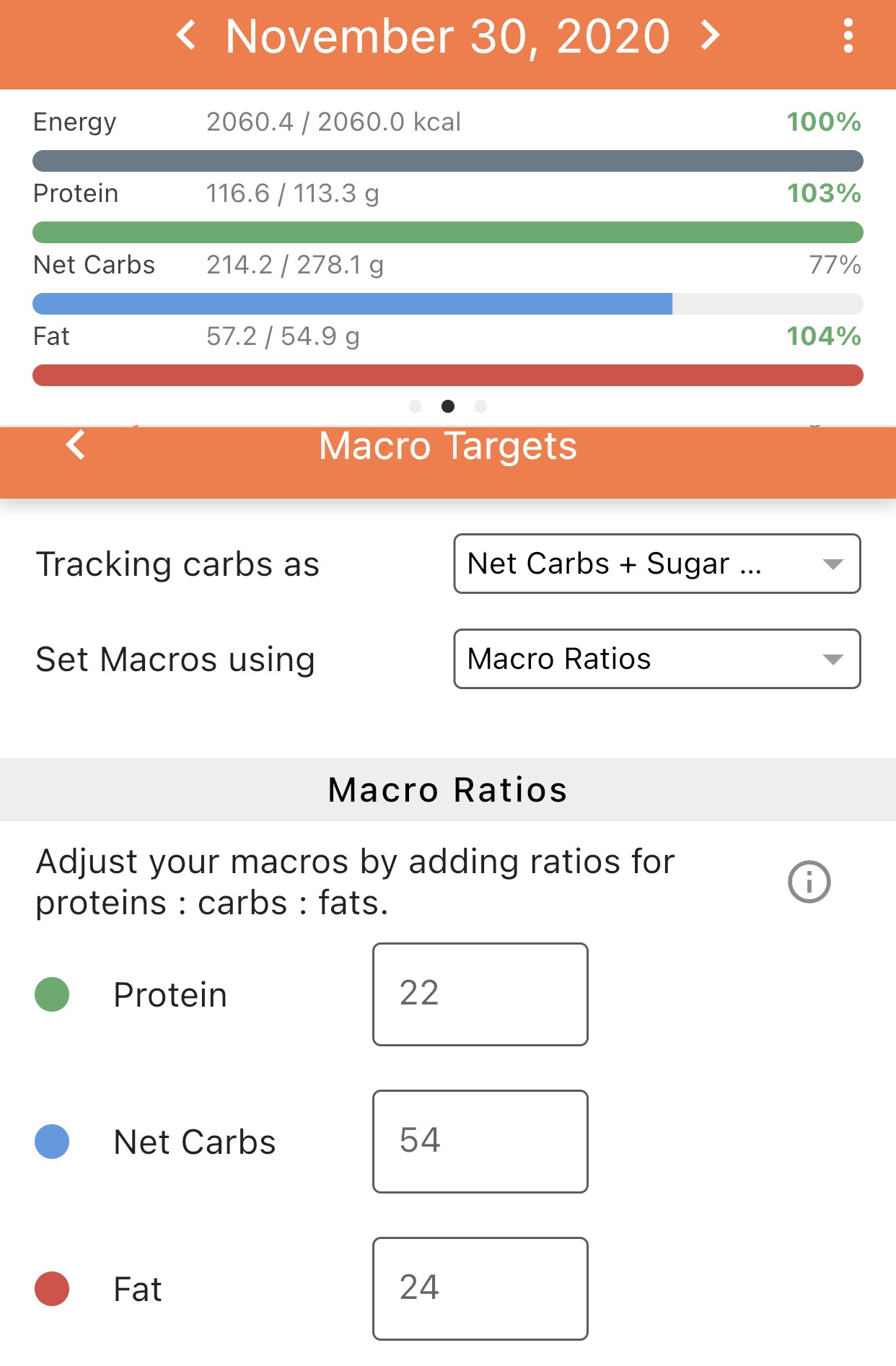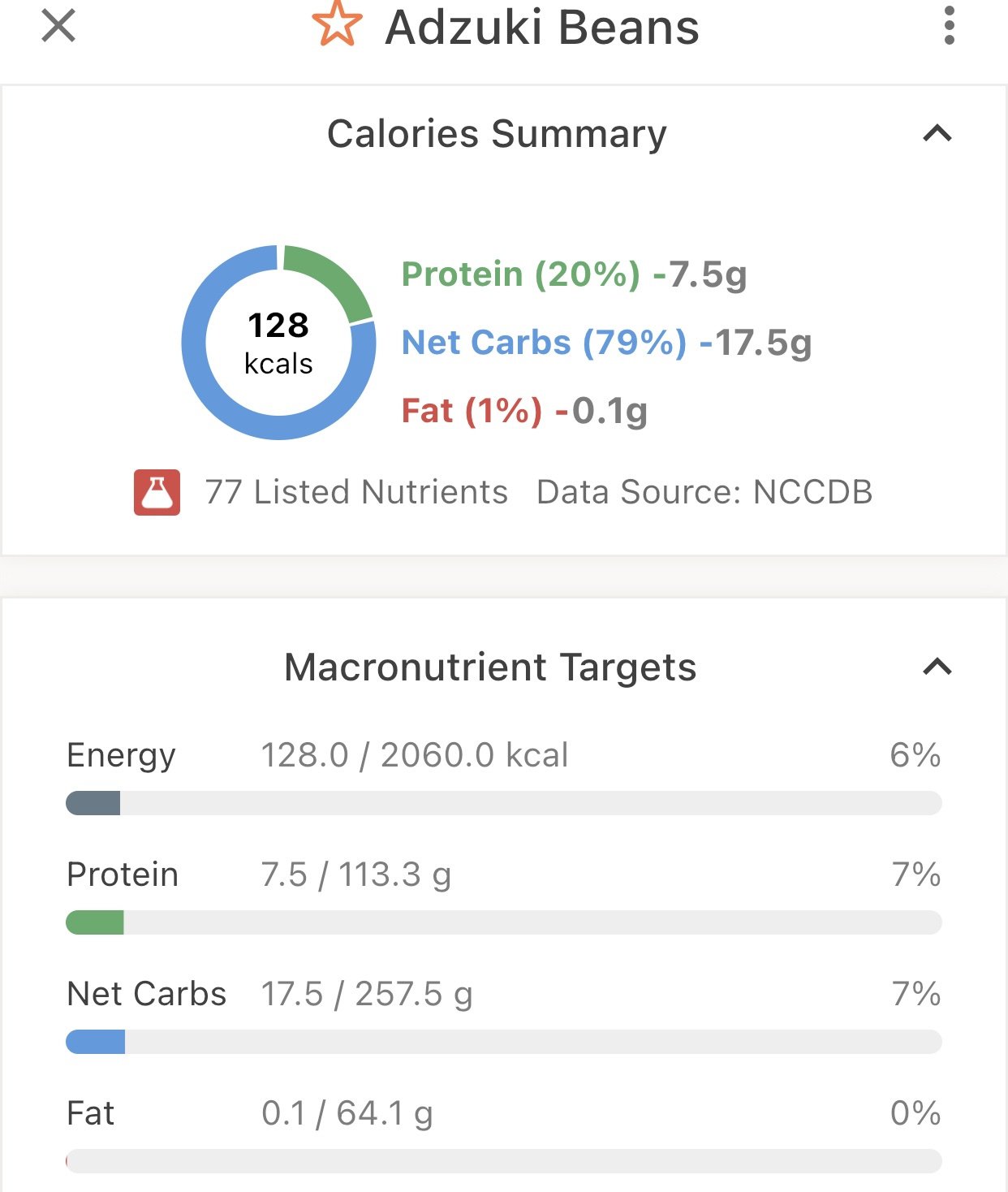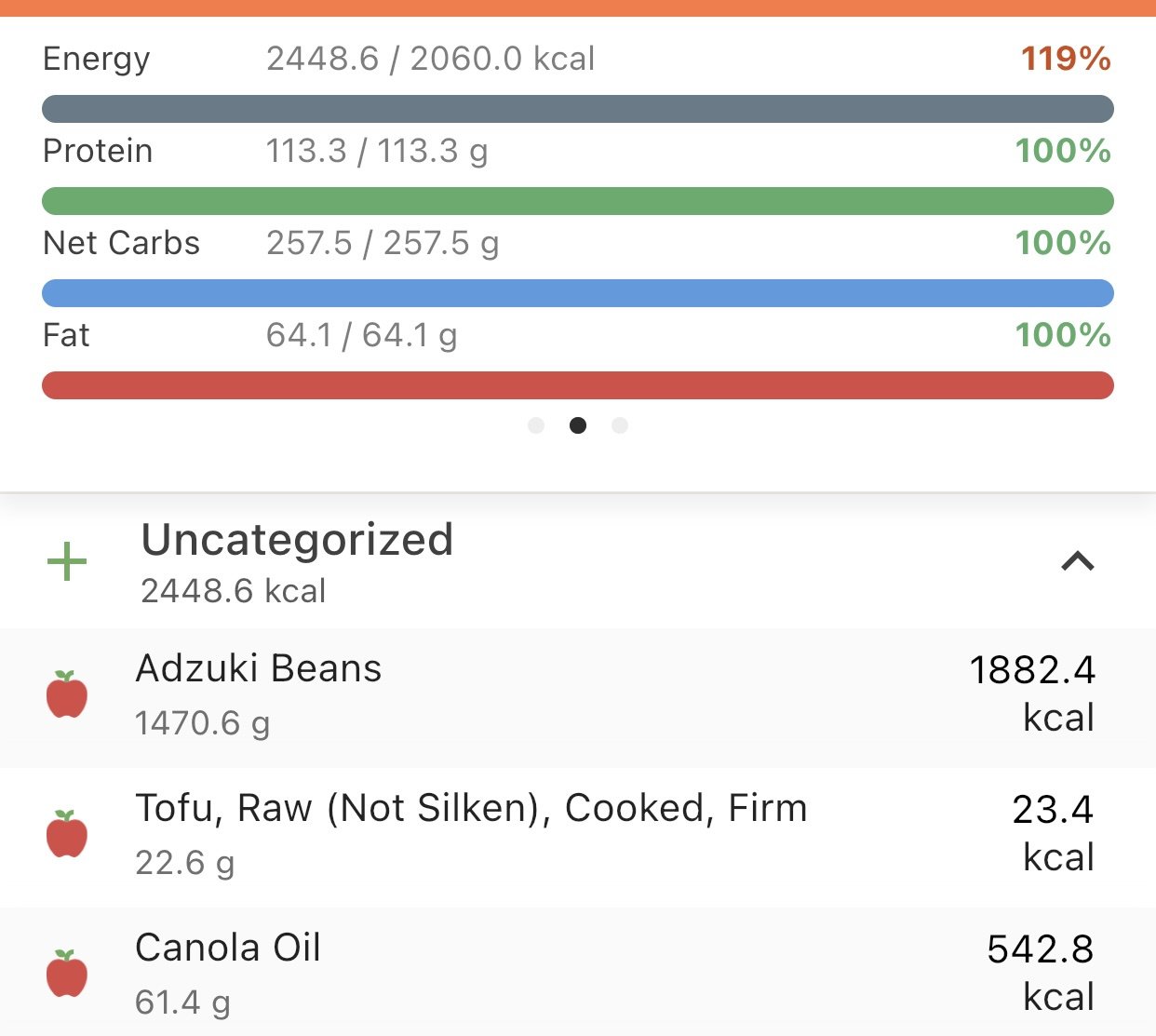Ratio of carbs calculated oddly from macro targets
I've been having some trouble using this feature. I made a menu which reflected what I wanted to be eating, but I wanted the macros to reflect the ratios I have in that menu (so that when I hit it, that daily target shows 100% and not less). So I input it as a full day into the diary, and wrote down the actual calories from each nutrient as the ratio targets, but somehow the ratios don't show 100% on all of them after I set them this way (I didn't understand whether ratios count the caloric target or nutrients in grams - but if it were nutrients in grams, I would have expected the fats to fuck up, not the carbs...)


Comments
-
Hi Selene,
The ratios define the percent of calories coming from energy. The software then calculates the grams of each for your targets based on your calories burned.
I see you are tracking net carbs in your targets; there will still be some energy coming from all sources of carbs so that is likely why your Net Carb target doesn't match up exactly with your energy.
Karen Stark
cronometer.com
As always, any and all postings here are covered by our T&Cs:
https://forums.cronometer.com/discussion/27/governing-terms-and-disclaimer -
Thanks, I added the net carbs and that fixed the ratio
 much better!
much better!I am still a little annoyed that it shows my targets as 93%-96% though - I want to be in a caloric deficit (losing weight), so I want it to calculate targets with the deficit in mind - is there a way to do that so it calculates the 100% using the calorie target (including exercise) instead of the calories burned?

-
Hi Selene,
This is a limitation of some of the nutrition data that we have. For example, brand name products report rounded values on the nutrition label. So, the grams of the macros may not add up exactly to the calorie amount given for that food.
If possible, try using generic alternatives from NCCDB and see if that makes a difference.
Karen Stark
cronometer.com
As always, any and all postings here are covered by our T&Cs:
https://forums.cronometer.com/discussion/27/governing-terms-and-disclaimer -
I have this issue too and think it has to do with how your macro ratios are getting calculated when in net carbs mode.
In total carbs mode everything works fine.
In net carbs mode I think that fiber is not being properly removed from the energy calculation so carbs always wind up out of whack on the report.
I think this is a major bug.
-
I can handily illustrate this.
The first screenshot is a day in Total Carbs mode. Everything looks normal:
Now here is the same day after switching to net carbs mode:
So the fiber is getting removed from the carbs bar, and that’s it! That’s not how this should behave.
Here’s my fiber for that day:
So the problem is that the caloric intake is being registered in net carbs mode as though the fiber fully counts calorically! That’s not an accurate picture though and defeats the purpose of a net carbs mode.
Determining net caloric value of fiber in foods is tricky, as you need to know the soluble and insoluble fiber amounts in foods to get an accurate picture. Insoluble fiber would generally go fully unavailable to your body, but soluble fiber is estimated at about 2 kcal/gram.
Cronometer lacks data about soluble/insoluble fiber ratios so any attempt at a useful net carbs mode would have to just take a guess at a caloric value for fiber. I’d say splitting the difference evenly and calling every gram of fiber worth 1 kcal is a good start.
So if I manually calculate my ratios based on the data for this example day, I could count my 74.9 grams of fiber as 74.9 kcals in net carbs mode. With that factored in, my caloric intake would be adjusted down from 2060.4 by 224.7 (the difference in the value of 74.9g normal carbs at 4kcal/gm to the value of 74.9g of our assumed 1:1 ratio of soluble:insoluble fiber at 1kcal/gm = 74.9*3 = 224.7).
So net carbs mode should have adjusted my caloric total down to 1835.7, and calculated my carb ratio weighting fiber at 1/4 other carbs.
This would get me values like this for the day:
Energy: 1835.7 / 2060
Protein: 116.6 / 113.3
Net Carbs: 232.9 / 278.1
Fat: 57.2 / 54.9
As it is, net carbs mode feels a bit useless and I’m better off using total carbs mode and just keeping a close eye on my fiber intake manually.
-
A nice thing too would be if the fiber filled up it’s proportion of the carbs bar in yellow in either mode! Total carbs it would be a full sized yellow section and net carbs it would be a 1/4 sized yellow section.
The last post was to illustrate the point, but also I’d like to demonstrate with a day where it is clearer how this makes targeting more difficult.
So here’s a day in Total Carbs mode:
Now the same day in net carbs mode:
So again, the only percentage or value that’s changing is the carbs bar. Not good! Fiber just vanished and nothing else is accounting for it.
For this day I had plenty of carbs, but in net carbs mode it looks like I’m still low because I had a lot of fiber.
To further illustrate how bad this is, I was actually slightly low of my fiber target this day:
So if I had hit the target it would have made the net carbs view even worse!
I have dug into this further now and you can even see in individual database entries how net carbs mode is not accounting for the caloric factor of fiber like it should.
Here’s 100g of Adzuki beans in Total Carbs mode:
And here’s the same in Net Carbs mode:
You can see the grams of carbs in net carbs mode goes down minus the amount of fiber (7.3g), but calories stays the same. This is nonsensical! As I said in the last post, there should be a factor like 1/4 to account for the net caloric effect of fiber. Otherwise net carbs mode is entirely misleading. Even just entirely subtracting the caloric value of fiber would be better than what’s happening currently.
I deliberately picked a very high quality database entry for a high fiber food to make this as obvious as possible.
I think the net carbs mode should show the food like this:
Energy: 108.2
(valuing fiber at 1kcal/g instead of 4kcal/g like total carbs mode does)
Protein: 7.5
Net Carbs: 17.5 (+1.8)
(Showing normal carbs and then in parentheses the weighted value of fiber)
Fat: 0.1
-
-
Hi there!
The NCCDB and USDA use energy factors that take into account the caloric content of carbohydrates in each food. Though we don't have data on the insoluble and soluble fibre content of these foods.
For example, Aduki Beans have an estimate 4.07 kcal/ g carbohydrate
from Food Data Central (point your mouse over the calculated energy): https://fdc.nal.usda.gov/fdc-app.html#/food-details/173728/nutrientsCronometer uses these energy factors to accurately calculate your energy intake whether you use total carbs or net carbs in your macronutrient target settings.
Karen Stark
cronometer.com
As always, any and all postings here are covered by our T&Cs:
https://forums.cronometer.com/discussion/27/governing-terms-and-disclaimer -
Well if that’s the case then I think the whole premise of net carbs mode is flawed then. As I’ve illustrated, putting in net carbs mode makes your carbs target wildly inaccurate if you use macro ratios and makes it literally impossible to hit all of your macro targets without going over your energy budget for the day.
-
To further make this perfectly clear. Here’s a day I just made up in net carbs mode with macro ratios using only entries from NCCDB:
-
I did find that it is literally possible to hit the targets in net carbs mode with macro ratios, but only if there is almost zero fiber in the diet. This synthetic day made it possible with nearly all carbs coming from pure sugar:
I think that the most sensible way to include a net carbs mode would be as I have described. Otherwise it should be disabled because it is very misleading.
-
Another thing you could do is replace net carbs mode with a carbs + fiber mode that allows people to select a value between 0-2 kcal/gram as a caloric value for fiber. Then just break out fiber as a 4th macro bar.
-
This was an early study on fiber composition of staple foods. There have been subsequent more extensive ones. Perhaps data from these could be incorporated. A good start would just be including fields for soluble fiber and insoluble fiber in your database to allow us to create custom foods with this data. Resistant starch content is also important and a factor effecting net caloric availability.
Notable from the abstract of that publication: “The soluble fiber fraction averaged 23% of the total fiber in refined grains, 3% in nuts, and 13% to 20% in the other food groups.” This suggests a default value of 0.4 kcal/gram of fiber would be a good ballpark estimate otherwise.
-
-
Another valuable field to have for a net carbs mode would be resistant starch. Estimate of net kcal/gram for resistant starches is 2.5. So that would be another significant factor for a more accurate view of the net available energy for a net carbs mode.
-
This page offers a nice summary of why the caloric value of carbs as determined by historic methods (i.e. Atwater) and reported in pervasive food databases (e.g. USDA and NCCDB) might be suspect: http://www.fao.org/3/aa040e/AA040E08.htm
Here’s the relevant section:
This is precisely what a net carbs mode should address: the caloric offset of a high fiber diet.
The best solution seems to be, especially given the amalgamation of data sources, allowing us to make an educated guess at the caloric value of fiber when the soluble:insoluble ratio is unknown (so, say, between 0-2 kcal/gram with a default at 0.4). When the actual soluble and insoluble fiber amounts are known we can use those values directly (0 for insoluble, 2 for soluble). Similarly, known quantities of resistant starch can be calculated at 2.5 kcal/gram.
This approach I feel would be the best compromise between the available data and the latest understanding of fiber and resistant starches’ effects on available energy.
-
With growing scientific consensus that a diet diversely full of whole food fiber sources is of paramount importance to long term human health, this is a great opportunity to be a leader in providing tools to make this clear and easy for people!
I’ve been reading Fiber Fueled and using Cronometer to improve my whole food fiber diversity. A more functional net carbs mode would be amazing! Thanks for what you’re doing.













